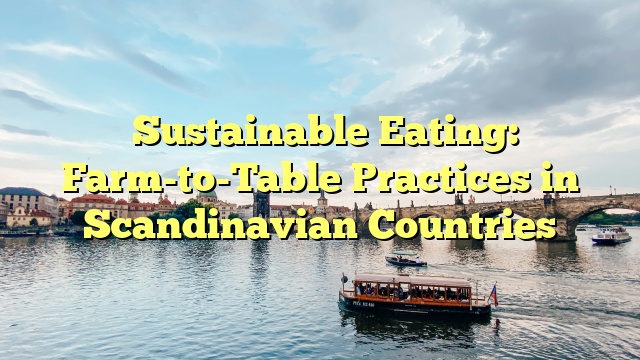Sustainable Eating and Its Importance
Defining Sustainable Eating
Sustainable eating is about choosing foods that are healthy for our bodies and have a minimal impact on the earth. It involves considering how our food choices affect the environment, economy, and society at large. By focusing on sustainable practices, we can work towards reducing waste, conserving resources, and ensuring that future generations have access to nutritious food.
Why Scandinavia? A Spotlight on Practices
Scandinavian countries, including Sweden, Norway, and Denmark, have long been recognized for their commitment to sustainability. The region’s dedication to environmental consciousness, coupled with a deep-rooted cultural appreciation for nature, makes it a leader in sustainable eating practices. The farm-to-table movement in these countries exemplifies how local production, seasonal eating, and environmentally friendly farming can exist in harmony.
The Farm-to-Table Movement
Understanding Farm-to-Table
The farm-to-table movement emphasizes sourcing ingredients directly from local farms and producers, ensuring that the food served is as fresh and environmentally friendly as possible. This practice reduces the carbon footprint associated with transporting food over long distances and supports local economies by promoting small and medium-sized farms.
Scandinavian Adaptation
In Scandinavian countries, the farm-to-table concept not only promotes sustainability but also connects people with their cultural roots. By focusing on locally grown produce and traditional farming methods, these nations have created a culinary landscape that respects nature and embraces seasonal variations.
Emphasis on Local Produce
In Sweden, Norway, and Denmark, there's a strong emphasis on sourcing ingredients like root vegetables, berries, and fish locally. This approach not only ensures the freshness and nutritional value of the produce but also supports local farmers and reduces dependency on imported goods.
Seasonal Eating Patterns
The Scandinavian climate, with its distinct seasons, naturally encourages seasonal eating. This practice encourages people to consume foods that are abundant during specific times of the year, reducing the need for artificial preservation methods and transportation.
Winter Offerings
During winter, hearty vegetables like potatoes, beets, and cabbages become staples, along with cured meats and preserved fish, reflecting traditional preservation methods that have been passed down through generations.
Summer Delights
Summers bring an array of fresh berries, leafy greens, and an abundance of seafood, connecting individuals to the rich flavors and nutritional benefits of the season's bounty.
Scandinavia's Commitment to Sustainable Practices
Organic Farming Techniques
Organic farming in Scandinavia is a widespread practice that avoids synthetic fertilizers and pesticides. Instead, farmers rely on crop rotation, composting, and natural pest control methods to maintain soil health and biodiversity.
Cultivation of Heirloom Varieties
Many Scandinavian farms grow heirloom varieties of fruits and vegetables, which are not only treasured for their unique flavors but also for their ability to thrive without the need for chemical interventions.
Livestock and Ethical Treatment
The treatment of livestock in these regions follows ethical practices, emphasizing animal welfare and environmentally conscious farming. Scandinavian farms often allow cattle and poultry to graze freely, promoting humane treatment and resulting in higher quality produce for consumers.
Efforts to Reduce Food Waste
Food waste is an issue faced by many countries, yet Scandinavia has made strides in minimizing this problem through innovative food policies and consumer initiatives.
Redistribution Programs
Programs that redistribute surplus food to those in need have gained popularity. These initiatives ensure that excess produce is directed to food banks and charities rather than being discarded.
Consumer Education Campaigns
Educational efforts aimed at teaching consumers about portion sizes, meal planning, and the importance of using leftovers have helped reduce food waste at the household level in Scandinavia.
The Role of Technology in Sustainable Eating
Innovative Agricultural Techniques
Technological advancements have enabled Scandinavian farmers to adopt more sustainable practices efficiently. Techniques such as precision farming and vertical farming are helping optimize resource use, minimize environmental impact, and increase productivity.
Precision Farming Benefits
Precision farming uses sensors and data analytics to monitor field conditions, ensuring that crops receive optimal care with minimal input waste. This method enhances yield while preserving soil health.
Embracing Vertical Farming
In urban settings, vertical farming offers an exceptional model for sustainable agriculture. These indoor farms utilize hydroponic and aeroponic systems to grow food in vertically stacked layers, reducing the land footprint and the need for chemical inputs.
Digital Platforms for Local Sourcing
To foster deeper connections between consumers and local food producers, digital platforms have emerged as vital tools in Scandinavia. These systems allow individuals to purchase fresh produce directly from nearby farms, promoting transparency, reducing middlemen, and further supporting farm-to-table operations.
Subscription Box Services
Businesses offering subscription boxes filled with local, seasonal fruits and vegetables have gained popularity, ensuring that consumers receive fresh produce regularly while enjoying the convenience of home delivery.
Farmers' Market Apps
Digital applications that connect consumers to real-time updates on farmers' markets enhance accessibility and encourage regular visits, thus strengthening the bond between consumers and local producers.
Cultural Elements in Scandinavian Sustainable Eating
Deep-Seated Traditions
The Scandinavian approach to sustainable eating is deeply rooted in cultural traditions that honor nature’s resources and promote mindful consumption.
Foraging Practices
Foraging for wild berries, mushrooms, and herbs has been an integral part of Scandinavian heritage. This practice not only yields fresh, organic produce but also educates individuals about the natural ecosystem.
Cooking Techniques
Traditional Scandinavian cooking techniques such as pickling, fermenting, and smoking preserve food naturally and infuse it with distinctive flavors that have become synonymous with regional cuisine.
Community Engagement in Sustainability
Community participation is a cornerstone of sustainable eating practices in Scandinavia, fostering a shared commitment to preserving the environment and local food systems.
Community-Supported Agriculture (CSA)
CSAs have become central to the Scandinavian sustainable food movement, enabling people to invest in local farms and receive shares of the harvest, thus establishing a direct link between producers and consumers.
Culinary Workshops and Festivals
Events like culinary workshops and food festivals celebrate local ingredients and educate the public about sustainable practices, creating a vibrant community dialogue around food and sustainability.
Challenges and Opportunities
Overcoming Barriers to Sustainable Eating
Despite Scandinavia’s strides towards sustainability, challenges remain, such as balancing economic constraints and ensuring widespread access to sustainable foods.
Cost Constraints
The higher cost associated with organic and locally sourced foods can be a barrier for consumers. However, economies of scale, governmental support, and educational outreach are helping reduce these barriers.
Expanding Access and Inclusion
Efforts to ensure that all members of society can participate in sustainable eating include government initiatives that subsidize and standardize organic farming and local produce distribution.
The Future of Farm-to-Table in Scandinavia
As the world becomes more aware of the environmental impact of food production, Scandinavian countries continue to innovate and inspire regarding farm-to-table practices.
Harnessing Innovation
Future developments in technology, policy, and community engagement are expected to further enhance the sustainability of the food system in Scandinavia, making sustainable eating accessible to a broader range of people.
Global Influence
Scandinavia’s farm-to-table practices stand as benchmarks for sustainability, with their methods and initiatives serving as models for global implementation. This international influence can potentially shift global food systems towards more sustainable practices.































